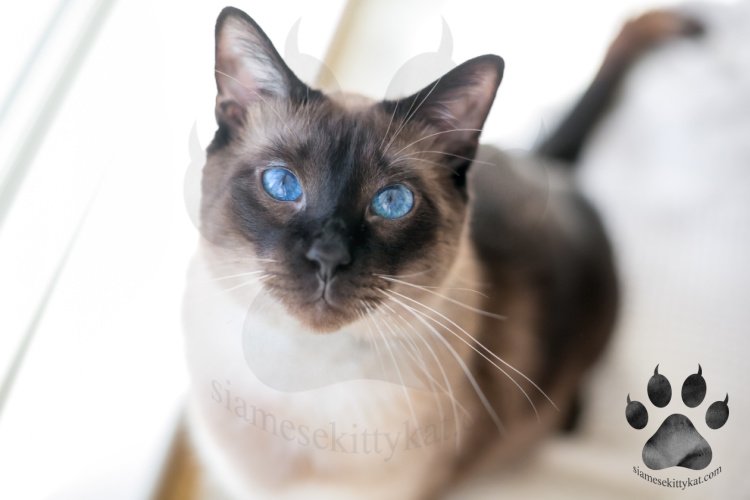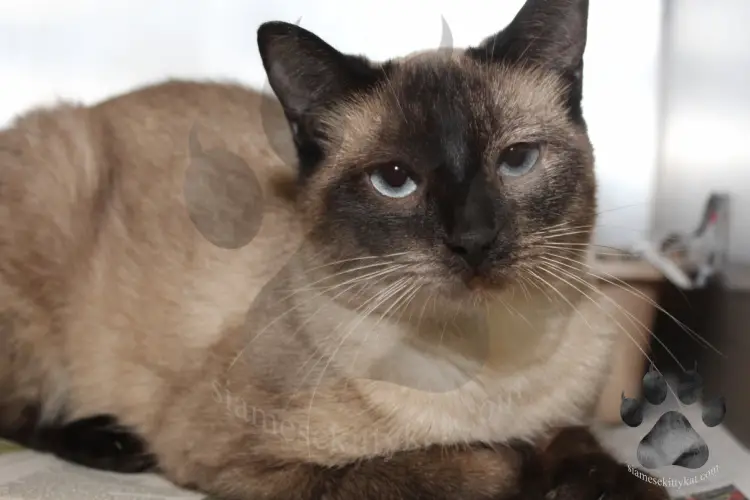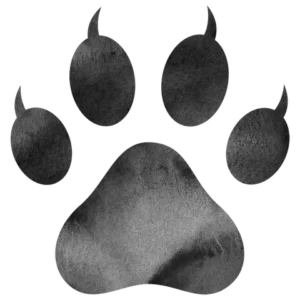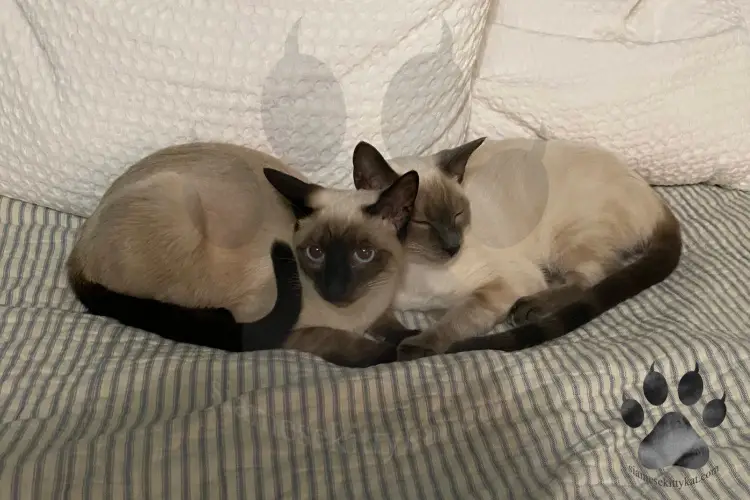Siamese cats are famous for their unique color point coats, sporting chocolate, blue, lilac, and even shades of red. I have two little Siamese cats at home; Batman and Robyn, who, while on occasion, drive me insane, are a massive part of my family.
Telling the difference between a Seal Point Siamese and a Chocolate Point Siamese can be tricky since they’re still the same cat breed, and the only difference is their markings, base coats, and paws.
If you have a Siamese kitty at home and you’re not too sure about their specific points, check this guide to find out all you need to know.
Are Seal Points and Chocolate Points the same?
While Seal Point and Chocolate Point Siamese are the same breeds, they are slightly different when it comes to appearance.
There are a variety of cats that can be Seal Point, including Himalayan and Ragdolls. ‘Point’ simply refers to different markings and color variations in a feline.
So what came first, the Seal or Chocolate Point? Well, according to experts, the Seal Point coloration found in felines started with Siamese cats, so that means that Seal Point Siamese has been around for thousands of years.
The Chocolate Point Siamese is a genetic variation of the Seal Point, first known to exist in the 1880s. In the early days of breeding, when a Chocolate Point was found in a litter of Seal Points, they were considered ‘bad seals.’ After a group of enthusiasts fought for the rights of chocolates, they were finally considered separate colors in the late 1950s.
The Chocolate Point is also less common and popular than the Seal Point.
What is the difference between a Seal Point and a Chocolate Point Siamese?
Distinguishing a Seal Point from a Chocolate Point can be difficult at first, but once you know what to look for, they’re pretty easy to tell apart.
1. Coats
Out of all of the Pointed Siameses, the ones that go through the most color changes on the body are Seal Point Siamese.
When a Seal Point is born, their coats are a pale cream color, turning to a darker brown shade as they age. The fur on their neck, belly, and chest tends to remain the same creamy color, whereas their back may turn a caramel-beige or dark brown.
When the Chocolate Point Siamese is a kitten, they will look just like the Seal Points. It’s not until they reach their teen years that they will develop their distinctive markings.
Despite the name, Chocolate Point Siamese is lighter than the Seals, with an ivory white coat that doesn’t change throughout their lives. It is possible to find a Choccie Point with a rich, cinnamon body; however, it is typically the latter.
2. Points
A Seal Point Siamese has dark brown spots on their face, ears, tail, and paws. A chocolate, on the other hand, will have a milk chocolate color on their face and paws, whereas their ears and tail are a slightly darker brown.
3. Paw Pads
A Seal Point Siamese will have dark brown paw pads, whereas a Choccie Point will be pink or have a pinkish undertone.
How much do Seal Point and Chocolate Point Siamese cost?
Since Chocolate Point Siameses are rarer than Seal Points, they are more expensive, especially if you are dealing with a well-bred feline:
Actually, you may not need to buy a Siamese friend, you can simply adopt one. I wrote an article that will help prepare you in becoming a fur parent plus places where you can adopt Siamese cats! Read it by simply going to the link above.
Why are Seal Point adults more expensive?
One of the reasons why adults tend to be more expensive than kittens is due to the fur changing color.
When Seal Points are born, their fur is completely white due to something called the Himalayan gene. As these kitties get older, their color points will begin to appear, and their fur may become darker.
The change in color can be affected by a range of things, including sun exposure, temperature, nutrition, and health of the mother, Siamese. Show judges tend to favor Siamese cats that have lighter fur. Therefore adults with said traits will be more expensive.
I actually made an in-depth research about Siamese cat color changes. I have shared the information I gathered through an article on this same website. Simply click the link and check it out.
Is Chocolate Point Siamese rare?
Yes! Choccie Point Siamese cats are rarer compared to their seal brothers and sisters. This is because every litter of Siamese kitten doesn’t guarantee the birth of Chocolate Points; you’re much more likely to find a Seal or Lilac point.
If you’re really lucky and match two parents with the same genes, you may get one or two Chocolate Points in your litter. A breeder friend of mine once got three kittens in their six kitty litter, and to say we were all surprised is a huge understatement!
You’ll never find an entire litter of choco kittens, though, two max in a five litter birth.
Are all seal points Siamese?

As I mentioned earlier, it is believed that the Seal Point coloration originated in Siamese cats, but nowadays, many other breeds can be Seal Point. These include:
What is the history of the Seal Point Siamese?
Despite being wildly popular in Thailand, it wasn’t until the late 1880s that the first Seal Point Siamese became popular in England. Pho and Mia were two imported Siamese, gifted by the King of Thailand to the British Consul General.
It seems like the Seal Point Siamese was introduced at the perfect time since England was in its prime era for cat shows and dog shows, putting the beautiful Siamese right into the spotlight among fancy breeds.
By the time the 1980’s hit, it is said that the Kingdom of Siam (Thailand) had begun importing Siamese kitties into the country because they were running out of them.
The Seal Point was considered a “higher class” feline, often kept by royalty and monks, where they guarded the temples and palaces, just as they did in Siam.
To this day, Siamese cats are considered one of the most recognized cats in the world!
Are color point cats albino?
Instead of being albino, you should consider Siamese cats to be temperature-sensitive albinos. Siamese cats do have pigment in their fur; it just takes a certain temperature to trigger the pigment into action.
All Siamese cats are born white, with a gene mutation named the Himalayan gene that controls the color of the fur. This gene will not work in warm temperatures inside their mother’s womb.
Once born, areas of your Siamese’s body that are colder (their tail, paws, face, legs) will begin to change color, creating what we know as “points.” The back of your Siamese is slightly cooler than the rest of their body and a little bit warmer than their points. That’s why you may see a light color patch on their back.
What determines whether your Siamese is a Seal Point or a Chocolate Point all lies within the modifiers of the kitten’s primary color gene.
Funny story, a friend of mine has a Siamese who got into an accident (that’s not the funny part, I promise, he’s totally fine now!), and he had to get his left side shaved for surgery. We were going through a particularly cold winter that year, and even though his house was warm and cozy, his bald spot stayed cooler than the rest of his body.
As the cat’s fur began to grow back, my friend noticed that it was a dark shade of chocolate instead of the ivory white across the rest of his body. We were both very surprised since it wasn’t the usual place for a point to turn up until we realized that it was due to his bald spot! That kitty is definitely a unique-looking Siamese.
Can point cats produce full-color cats?
No, Seal Point or Chocolate Point cats cannot produce a full-color cat. This is because the Himalayan gene (cs) is recessive, meaning a feline must inherit two copies of the Himalayan gene to become a point.
So, if you breed a Pointed Siamese with a brown cat that doesn’t carry the Himalayan gene, all the kittens will be brown.
However, solids, bi-colors, or tabbies can produce a pointed cat if they carry one Himalayan gene. That’s why you may find a one-pointed kitty in a bunch of non-pointed cats.
I know this can be a little confusing, so let me give you an example! (c) refers to a full-color gene, whereas (cs) refers to a pointed gene. All cats inherit two genes, one from each parent.
A brown cat that carries the Himalayan gene (c / cs) mates with another brown cat that carries the Himalayan gene (c / cs), producing five kittens.
Is Chocolate Point Siamese hypoallergenic?

While all Siamese cats are less likely to trigger a person’s allergies, there is actually no such thing as a hypoallergenic cat.
While most people believe that allergies are triggered by long fur, it’s actually due to a protein called Fel D 1 found in cats’ and dogs’ skin, urine, and saliva.
The reason why Siamese cats are considered hypoallergenic is that they simply produce less Fel D 1 than other cats, and it does help that they shed less than your typical feline too.
What are the most popular Siamese cat color?
Due to hundreds of years of cross-breeding, there are now many types of Siamese cats out there. While there are only four types of Siamese that are counted as official color variations (Seal, Chocolate, Blue, and Lilac Point), more and more types are becoming popular.
Two Siamese cat colors that are as similar as chocolates and seals are blue points and lilac points. Confused about the two? Simply click the link to read an article that will help you tell them apart.
Here are nine other popular Siamese colors other than the Seal and Chocolate Point:
Blue Point Siamese
Blue Point Siamese are known for their silvery, almost slate-like bodies and blue-gray points found on their ears, tail, face, and paws. Blue Points may have some blue shading under their bellies or backs.
These icy felines have dark grey noses and paw pads, contrasting well with their bluish-white fur.
Lilac Point Siamese
It was the 1960’s when the first Lilac Point was recognized as an individual color breed. These pretty kitties can also be referred to as “Frost Point” due to their frosty pink tone.
They are the lightest of all the Siamese colors, with soft pink paw pads and noses. They are also among the rarest and sought-after Siamese kitties and are often considered the “watered-down” version of a Choccie Point.
Flame Point Siamese
As the name suggests, these fiery Siamese sport red or orange points on their faces, ears, legs, paws, and tales. Their nose leather and paw pads are a pinkish color, with ivy bodies.
Flame Point Siamese cats were created by breeding tortoiseshell tabbies and red tabbies.
Cinnamon Point Siamese
The Cinnamon Point Siamese has a bright, ivory-colored body, with warm, cinnamon-like points on their tails, face, ears, and legs. Their legs tend to be a slightly lighter color compared to their other points. They have pinkish-brown paw pads and nose leathers, with a light brown rim around their eyes.
Like the Lilac Point Siamese, these cinnamon kitties are considered a watered-down version of the Chocolate Point.
Cream Point Siamese
The Cream Point Siamese sports a soft white body with orange and red points on their face, ears, paws, and legs. Their nose leather and paw pads are pale pink in color.
Cream Point Siamese kitties are often confused with the Red Point Siamese. This makes sense since this colorway was made by breeding the Red Point Siamese and the Domestic Shorthair.
Lynx Point Siamese
Lynx Point Siamese, also referred to as the Tabby Point, was made in a total oops moment, when a Seal Point Siamese bred with a Tabby cat. What was created was a beautiful striped kitty, often with a cream coat and greyish-blue points.
They really do look like a little lynx (hence the name), and they can often be dotted with lilac, brown, or even tortie-colored points. These kitties are rarer than your typically Siamese cat, but they aren’t that difficult to find.
Caramel Point Siamese
Much like Seal Point Siamese, the Caramel Point develop their colors slowly and may even look like Blue or Lilac Point Siamese kitties, to begin with.
The Caramel Point has an off-white coat, which darkens over time, and blueish-brown points on their faces, ears, tails, legs, and paws. They have soft gray eye rims and greyish-pink noses and paw pads.
You can also get Caramel Point Siamese that resembles Fawn Points. The fawn-based ones will have a more pale tone, with brownish-gray and almost pink points.
Fawn Point Siamese
These pretty kitties look quite similar to Lilac Points, with creamy white bodies and soft mushroom-like points on their faces, ears, tails, and paws. Unlike the Seal or Chocolate Point Siamese, fawnies have fewer pigments in their points, almost blending into their fur.
Fawn Points have pink nose leathers and paw pads.
Apricot Point Siamese
Again, Apricot Point Siamese look very similar to the Flame Point Siamese. However, they will often darken as they get older. Their bodies are a creamy white, and their orange and red points have an almost metallic shine to them. Their legs and feet are often a paler shade of orange compared to their other points.
The paw pads, nose leathers, and eye rims are pale pink, and their lips can even develop freckles (how cute!)
Regardless of their point color, Siamese cats love to play. You can check out their favorite toys here. I even included the 1 toy that made my Batman and Robyn as happy and playful as they are right now. It’s a cat tower which I bought on Amazon. Simply click the link if you’d like to buy one for your cats too!
Are Chocolate Point Siamese And Seal Point Siamese Different?
All in all, Chocolate Point and Seal Point Siamese really aren’t that different.
The main difference between these pretty kitties is the colors on their faces, tails, ears, and paws. Other than that, they are both extremely lovable, loud, and adored by many.
As time goes on, more and more Siamese are being bred, and different color variations appear. As of now, only four colorways are recognized as official Siamese; however, I’m sure it won’t be long until that list has grown!
Be the Siamese Cat expert you always wish to be! From color points to similar cat breeds, discover everything you need to know about their unique charm and characteristics in our comprehensive guide: Siamese Cat Breed: Types, Color Points and Comparison to Other Cat Breeds
Get your FREE Siamese Cat 2024 Printable Calendar



